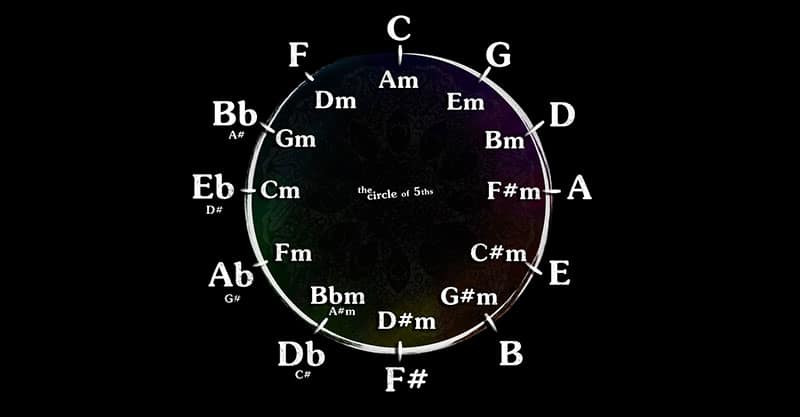Continue to discover how to use the circle of fifths in your songwriting…
Minor keys on the circle of fifths in your songwriting
So far I’ve covered all the main keys you may construct with sharps and flats in the key signature.
Next up are the minor keys.
Fortunately, there’s nothing new to study right here because the minor keys all have a relative main that shares the identical key signature.
You should utilize the identical methodology of moving left and right by fifths while adding sharps and flats in case you begin in the proper place.
Right here’s what I imply. The relative minor of a major key’s the dimensions that begin on scale degree six of the major scale.
Merely comply with the key signature of the main key and count up six scale degrees to seek out its relative minor.
In C major, that signifies that A minor is the relative minor key. These keys share an identical key signature that contains no accidentals.
The identical holds true for the rest of the relative minors. That signifies that in case you prepare the minor keys around the circle with the identical approach starting on A, you may easily discover the key signatures.
For instance, take the key of F# minor. To seek out the signature, move clockwise on the circle by three steps adding sharps each time. You’ll find yourself with F#, C#, and G#—identical because the relative main key of A major!
The way to use the circle of fifths in your songwriting
Thus far this explainer might seem theoretical, however, there are many methods to use the circle of fifths in actual life.
Listed here are only a few methods it could work in your music.
Discover out where you’re
Once you’re improvising music, jamming with a buddy, or trying to play along to music, the first thing you’ll have to know is the key.
In that method, you’ll know which notes to play and which chords have an important harmonic function.
There are a number of methods to seek out the key, together with a super handy automatic method for those who’re working in a DAW.
However, with a bit of ear training, most musicians can easily determine the tonic (or scale degree 1) because of its stable sound and sense of harmonic “home.”
When you have the tonic, you may fill in the rest of the notes by remembering the sharps and flats in the key signature with the circle of fifths.
Change keys
Loads of nice songs stay in the identical musical key throughout. However, others make use of a dramatic approach known as a key change or modulation.
Some songs modulate on to a new key for recent sound after a repeated part.
However, others change keys easily by moving to an associated key.
The circle of fifths offers you clues about which keys share the most DNA. If two keys are next to each other on the circle, their key signatures differ by only one unintended!
This implies altering between them won’t sound jarring for listeners.
Hot tip: Some keys are so related that they share a few identical chords. When used as a bridge between two associated keys, these are known as pivot chords.
Borrow chords
When you’ve performed around a bit with the diatonic chords, you may need to branch out a bit.
A number of the most fascinating chord progressions characteristic chords brought in from outside the home key.
These are known as borrowed chords and so they can add excitement and uniqueness to a track.
Borrowed chords come most frequently from keys that might be associated with the home key. For instance, the most generally used secondary dominant chords are V7/V and V7/IV. These come from adjacent keys on the circle of fifths.
However, regardless of which keys your borrowed chords come from you’ll still have to construct and spell them correctly to use them. You possibly can’t do this without figuring out the notes of the keys where they appear!
Circular logic
The circle of fifths is taught everywhere in music education.
Whereas it might sound like a boring technical element, it’s a foundational idea that may assist you to discover your approach around the fundamentals of music idea.
Whether you’re trying to feel at home in your instrument, jam together with your mates, or discover fresh chords, studying the way it works will assist construct your skills.

